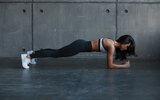01dragonslayer
Ripped
- Jacked Cash
- 471,178
A goal of many fitness-loving individuals is to make each workout better than the last. We've been told the harder you train, the better, right?
Let’s be clear about this. The iron game is not an easy one to play, nor is it meant to be. However, the idea of training “harder” may be confusing for some people. To most people, harder is perceived as using more plates, bigger dumbbells, and stacking machines. This is definitely training heavier, which is harder, but what if you train from home and have limited weights available?
The good news is that adding more sets, reps, or weight isn’t the only way to train harder. There are several ways that you can make your training sessions more challenging, and you can incorporate these seven strategies in your workouts at home and at the gym.
Recommended: Need help building muscle? Take our Free Muscle Building Course
Now let’s take that to another level. Imagine yourself going down for a squat, then stopping at the bottom for a second before standing back up. No momentum can be generated. The quads and glutes have to fire in order for you to generate the force. Doing that for a few reps will make a set more challenging than using the same weight while doing the normal version.
Related: Pause Rep Workout Program for Serious Strength Gains
Doing longer negatives throughout a set can definitely make it harder. Consider the lateral raise. Perform a set of 10 reps with light weight as you normally would. After a minute or two, do another set, but this time take 10 seconds to lower the weight for each rep. The ability to control the weight will be much more difficult by the end of that set.
You can do negatives like this for dumbbells, barbells, machines, bands, or even your body weight. The sets will last longer, but you will see results from incorporating these negatives in various exercises.
Related: Eccentrics: Build Strength With Heavy Negatives

Have you ever tried holding the contracted position for an extended time? Perform a barbell curl and squeeze the biceps at the top of the curl for five seconds before lowering the weight. It may feel good for the first 4-6 reps, but then muscular fatigue will take over and you’ll have to work harder to control that flexing.
If you do this at the beginning of your biceps training, then your muscles will be pre-exhausted, which can make the following sets more challenging. If you save this tactic for the end, then you can leave the gym knowing the job was done effectively.
The best part? You can perform circuits with any exercises you want. You can focus on one body part, like shoulders, split the workouts into groups like upper body and lower body, or do a full-body circuit. Regardless of the decision you make, shooting for three to five rounds of three to five exercises can help you perform a lot of sets in minimal time. Your endurance will be challenged as well.
Related: Building The Perfect Fat Burning Circuit

Chances are, you will get more than you anticipate. Challenge yourself to do this for one whole session. You can vary the time you work for, too. If you want to use heavier weight, your timed set could be for 30 seconds. If endurance is your focus, go for 1-2 minutes.
Related: EMOMs for Time-Efficient Training (Plus 8 Workouts Under 20 Minutes)
The normal idea is to superset two weight training exercises and performing them back-to-back. Instead, perform one movement with weights, and another that focuses on cardiovascular benefits. One example could be dumbbell lunges with jump rope for one minute. Another could be doing shoulder presses with kettlebell swings. The combinations are endless, and so is the potential.
Let’s be clear about this. The iron game is not an easy one to play, nor is it meant to be. However, the idea of training “harder” may be confusing for some people. To most people, harder is perceived as using more plates, bigger dumbbells, and stacking machines. This is definitely training heavier, which is harder, but what if you train from home and have limited weights available?
The good news is that adding more sets, reps, or weight isn’t the only way to train harder. There are several ways that you can make your training sessions more challenging, and you can incorporate these seven strategies in your workouts at home and at the gym.
Recommended: Need help building muscle? Take our Free Muscle Building Course
1. Incorporate Pauses
Stopping a movement mid-rep can definitely make an exercise more challenging. Let’s use the basic barbell squat as an example. You lower yourself down into the hole, then you normally push immediately to return to the standing position. Squats as a normal exercise can be challenging.Now let’s take that to another level. Imagine yourself going down for a squat, then stopping at the bottom for a second before standing back up. No momentum can be generated. The quads and glutes have to fire in order for you to generate the force. Doing that for a few reps will make a set more challenging than using the same weight while doing the normal version.
Related: Pause Rep Workout Program for Serious Strength Gains
2. Use Longer Negatives
For those of you that are new to training, the negative, or eccentric portion, of a repetition is when you go from a position where the muscle is contracted to the point that it is stretched. A typical negative may take one or two seconds to perform, unless you simply let the weight drop, which isn’t a good idea.Doing longer negatives throughout a set can definitely make it harder. Consider the lateral raise. Perform a set of 10 reps with light weight as you normally would. After a minute or two, do another set, but this time take 10 seconds to lower the weight for each rep. The ability to control the weight will be much more difficult by the end of that set.
You can do negatives like this for dumbbells, barbells, machines, bands, or even your body weight. The sets will last longer, but you will see results from incorporating these negatives in various exercises.
Related: Eccentrics: Build Strength With Heavy Negatives

3. Squeeze the Muscles
Now let’s focus on the other portion of the rep: when the muscle is contracted. Generally, you want to squeeze the muscle when it’s in the contracted position. This helps you feel it while it’s working so you know you’re using good form.Have you ever tried holding the contracted position for an extended time? Perform a barbell curl and squeeze the biceps at the top of the curl for five seconds before lowering the weight. It may feel good for the first 4-6 reps, but then muscular fatigue will take over and you’ll have to work harder to control that flexing.
If you do this at the beginning of your biceps training, then your muscles will be pre-exhausted, which can make the following sets more challenging. If you save this tactic for the end, then you can leave the gym knowing the job was done effectively.
4. Perform Circuits
If you have to make the most out of the time you train but still want it to be a hard session, circuits are a great option to consider. You can perform several movements in a row without taking a break until you finish the complete rotation.The best part? You can perform circuits with any exercises you want. You can focus on one body part, like shoulders, split the workouts into groups like upper body and lower body, or do a full-body circuit. Regardless of the decision you make, shooting for three to five rounds of three to five exercises can help you perform a lot of sets in minimal time. Your endurance will be challenged as well.
Related: Building The Perfect Fat Burning Circuit
5. Keep Rest to a Minimum
Perhaps the thought of doing circuits isn’t that appealing, but you do want to focus on efficiency as well as effectiveness. All you need to do is decrease your normal rest periods. If you’re used to resting for one minute between sets, then reducing that to 30 seconds is going to be a shock to the muscles. You may not be able to go as heavy with your weight, or you may not be able to perform the same number of reps as you could before, but those can serve as goals for you to work towards. If you can get to the point that you do the same work with less rest time, then you’re getting better.
6. Go for Time Instead of Reps
There is another hard fact that you may need to come to terms with. You may be more capable than you realize. How many times have you done sets of 10 or 12 and finished with that? You really want to know how strong you are? Set the timer for one minute and see how many reps you can do (with proper form) before the clock runs out.Chances are, you will get more than you anticipate. Challenge yourself to do this for one whole session. You can vary the time you work for, too. If you want to use heavier weight, your timed set could be for 30 seconds. If endurance is your focus, go for 1-2 minutes.
Related: EMOMs for Time-Efficient Training (Plus 8 Workouts Under 20 Minutes)
7. Superset Weight Movements with Cardio
Now we come to the major elephant in the room for some folks. If there is anything getting skipped due to time or any other reason, it may be cardio. This doesn’t have to be the case. You can focus on the muscles and burn calories, too. This is thanks to supersets.The normal idea is to superset two weight training exercises and performing them back-to-back. Instead, perform one movement with weights, and another that focuses on cardiovascular benefits. One example could be dumbbell lunges with jump rope for one minute. Another could be doing shoulder presses with kettlebell swings. The combinations are endless, and so is the potential.

